North Korea is most probably not on the top of your bucket list regarding countries you plan to visit any time soon. That being said, its capital city Pyongyang is still home to some remarkable structures.
The capital of North Korea is situated on the banks of the Taedong River, one of the major rivers in the country which releases into the Yellow Sea about 109 kilometers (68 miles) downstream.
Because everything in North Korea is secretive, it’s hard to estimate how many people live in the capital.
According to a 2008 census report, it has a total population of 3,255,288. A 2016 report indicated a serious decrease with a population of just 2,870,000.
In this post, we’ll take a closer look at some of the most famous buildings in Pyongyang, architecture in what is the most secretive, yet intriguing country in the world!
1. Rungrado 1st of May Stadium
The Rungrado 1st of May Stadium is the biggest stadium in the world with an estimated seating capacity of 114,000.
It’s located on Rungra Island which is located in the Taedong River in the center of the city. This makes this enormous stadium one of the most incredible landmarks in Pyongyang.
The stadium covers a huge area of about 20.7 hectares (51 acres) and is used for a wide variety of purposes, including soccer matches, athletics, and most spectacularly, mass games.
There’s also word around the campfire that the stadium is being used for public executions of people who the regime doesn’t like.

Regardless of its infamous nature, the mass games surely look impressive.
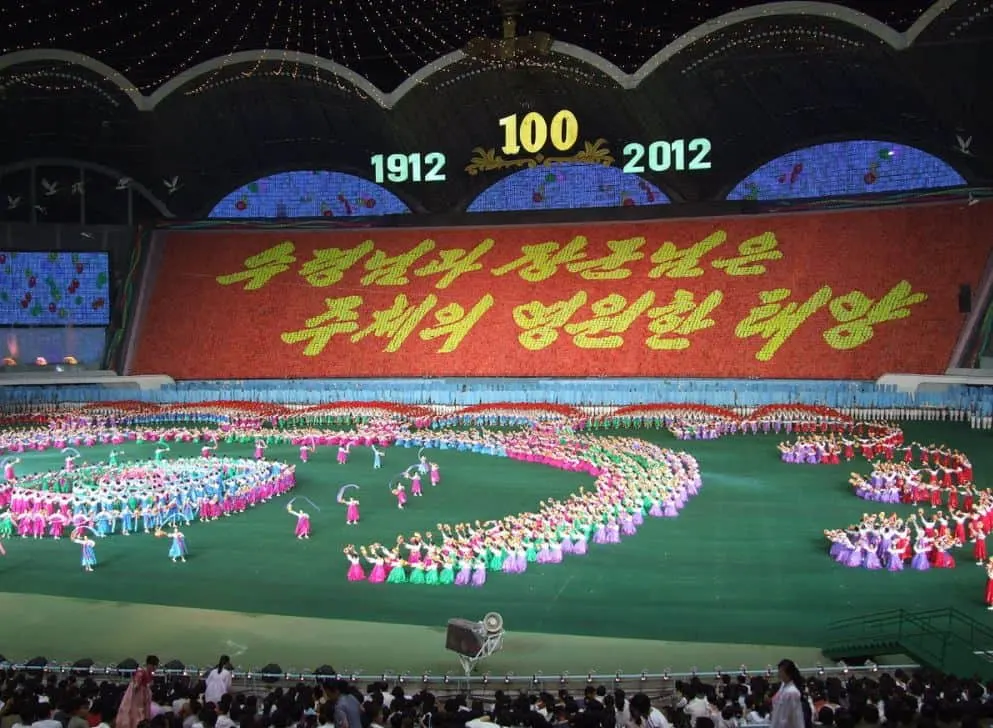
2. Juche Tower
The Juche Tower is a fascinating tower that was built in honor of the ideology of the country’s regime which is called “Juche.”
This ideology resembles the ideas of Communism even though it incorporates some typically Korean elements.
It was devised by the first leader of the country called Kim Il-sung (1912-1994), the man all North Koreans shed incredible tears for whenever there’s a mass parade in his honor.
The tower was completed in 1982 to commemorate Kim Il-sung’s 70th birthday and that comes with a remarkable story.
The tower was built with a total of 25,550 blocks, a block for each day the man had lived until then. They didn’t include leap years to make calculations a bit easier.
The tower stands 170 meters (560 feet) tall and is topped with a 20-meter (66 feet) high torch that is illuminated at night, making it one of the most prominent landmarks in the city.

3. Arch of Triumph
The Arch of Triumph is an incredible triumphal arch that was built to commemorate the Korean resistance to Japan between 1925 and 1945.
Shortly after, the country of North Korea with its one political party was established.
It’s the second tallest of its kind in the world at a height of 60 meters (197 feet), with only the Monumento a la Revolución in Mexico City being taller.
They did make it a bit taller than the arch it was modeled on though, the Arc de Triomphe in Paris. It stands 60 meters (197 feet) tall and is 50 meters (164 feet) wide.
The arch is located on the “Triumph Return Square” at the foot of Moranbong or “Moran Hill,” a hill with a height of 95 meters (312 feet) above sea level in the center of the city.
It was completed at the same time as the Juche Tower in 1982 and for the same reason as well. This also means that it was constructed with a total of 25,500 blocks of white granite, quite amazing.
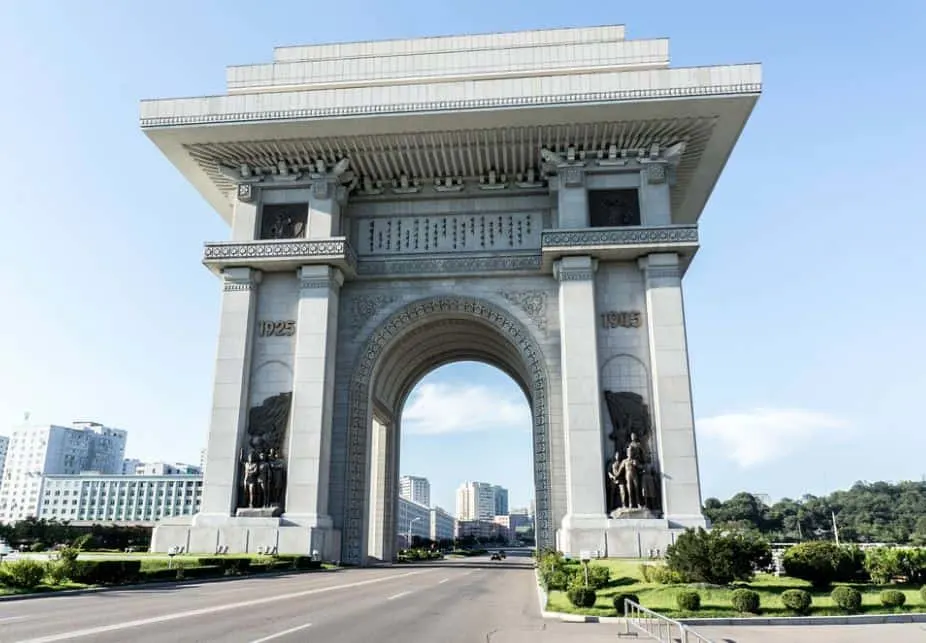
4. Kim Il Sung Square
Kim Il Sung Square is the most famous square in the capital of North Korea and was completed during the rebuilding of the city in 1954 following the Korean War.
It’s situated right across from the Juche Tower on the opposite bank of the Taedong River.
It’s also one of the most iconic locations in Pyongyang because whenever we see footage of military parades as the regime flaunts their massive bombs, this is where that happens.
And of course, the square was named after the first leader of the regime as well.
The square was built at a monumental scale and covers an area of 75,000 square meters (807,293 square feet). This means that it can accommodate a total of 100,000 spectators.
Remarkably, if there’s no special event taking place, the square is pretty much empty.

5. Mansudae Grand Monument
The Mansudae Grand Monument is a collection of monumental statues that commemorate the revolutionary struggle of the Korean people and glorify the leaders.
Therefore, the centerpieces of this complex are 2 monumental statues of deceased leaders Kim Il-sung and Kim Jong-il.
The bronze statue of Kim Il-sung stands 20 meters (66 feet) tall and was constructed in 1972 to commemorate his 60th birthday.
The additional statue was added in 2011. The entire complex features a total of 229 figures.
As expected, all of these monuments are related to the struggle of the Korean people resisting the Japanese before World War II.
If you look closely behind the two main bronze statues you can also see a mural depicting Mount Paektu. This active stratovolcano is considered to be sacred in North Korean culture.
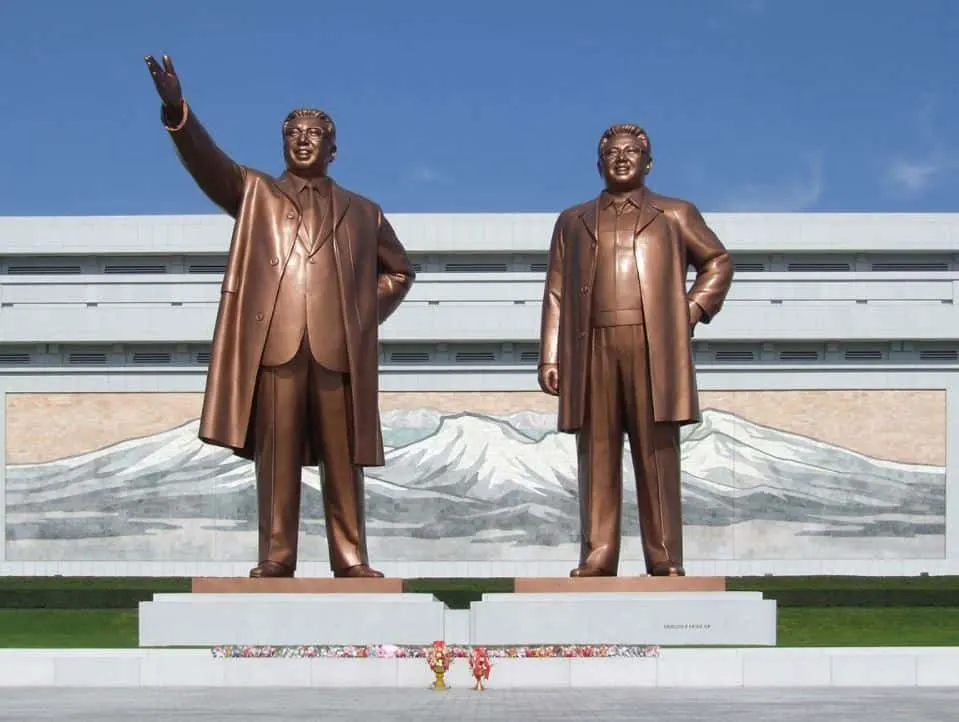
6. Kumsusan Palace Of The Sun
The Kumsusan Palace of the Sun was originally referred to as the “Kumsusan Memorial Palace” because it served as the Mausoleum of Kim-Il-sung.
This enormous structure was completed in 1976 and is situated on the northeastern edge of the city center.
This wasn’t the original purpose of the building, though, because Kim Il-sung only died in the year 1994.
It was constructed to serve as his official residence, and it was designated as his final eternal resting place as well, together with his son Kim Jong-Il.
This huge building covers a total area of 10,700 square meters (115,000 square feet) and some corridors are reportedly over 1 kilometer (0.6 miles) long, quite astounding.
These dimensions make it the largest mausoleum dedicated to a Communist leader in the world, and the only one that has 2 of them on display.
Converting the former residence to a mausoleum wasn’t cheap as it’s estimated that it cost anywhere between USD 100 and 900 million in the 1990s, an enormous sum for a country that isn’t in great shape financially, that’s for sure!
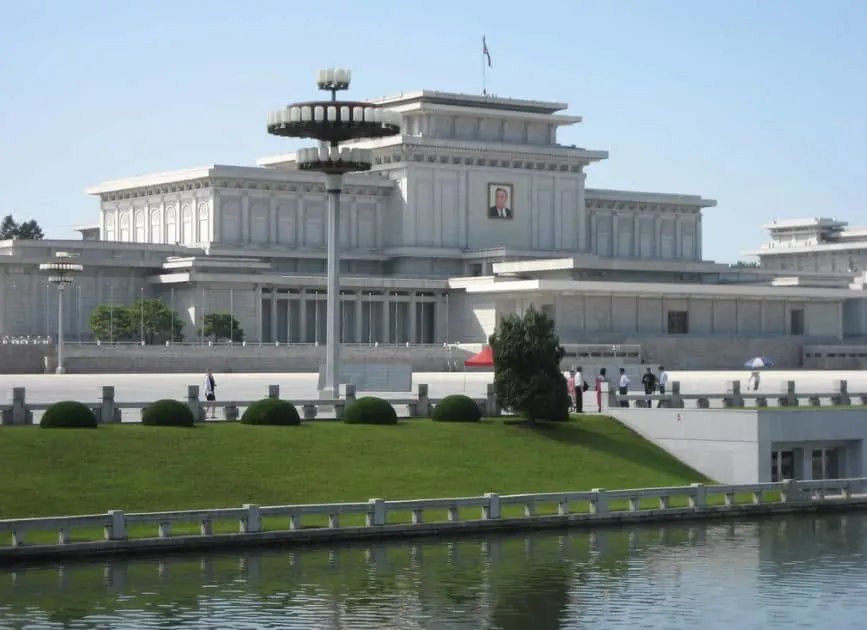
7. Ryugyong Hotel
The Ryugyong Hotel is without question the most remarkable skyscraper in Pyongyang.
The building has 105 stories and stands 330 meters (1,080 feet) tall. It’s a pyramid-shaped building that dominates the skyline of the city.
What’s intriguing about this landmark in Pyongyang is that it remains unfinished until today.
This has resulted in the building being listed by the Guinness World Records as the “tallest unoccupied building in the world.”
Most of the building was constructed between 1987 and 1992 but a serious financial crisis halted the work.
The exterior was finally completed between 2008 and 2011 and there was even an announcement that the hotel would open in 2012 but this never happened.
They did, however, add huge LED lights in 2018 which are used to display propaganda movies, the only purpose of this structure until today.

8. Revolutionary Martyrs’ Cemetery
The Revolutionary Martyrs’ Cemetery is a huge cemetery and memorial dedicated to the Koreans that fought against Japanese rule.
The complex is situated near the top of Mount Taesong on the outskirts of Pyongyang. The mountain stands 270 meters (890 feet) tall and overlooks the city.
The cemetery features hundreds of tombs and was originally completed in the year 1975. It covers a total area of 30 hectares (74 acres) and also houses the tombs of some of the most prominent people of the regime
These include the mother of Kim Il-sung called Kang Pan-sŏk, and his first wife called Kim Jong-suk, among multiple military leaders.
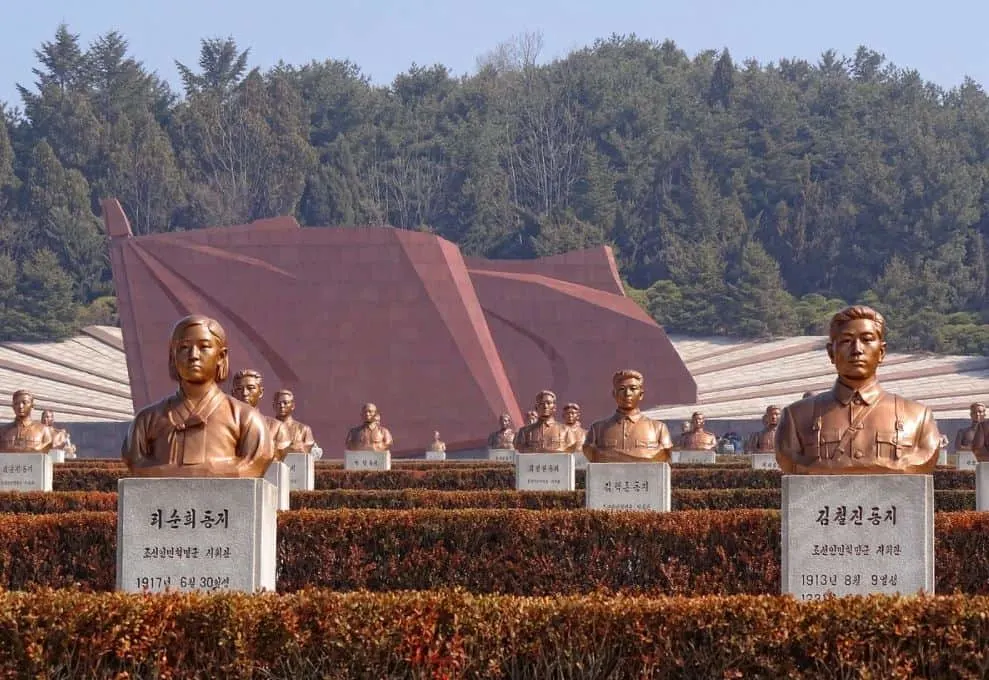
9. Mansudae Assembly Hall
The Mansudae Assembly Hall is the official seat of the Supreme People’s Assembly of North Korea.
It’s located just to the west of the southern tip of Rungra Island near the Taedong River and is the most important government building in the country.
The enormous meeting hall inside the building covers an area of 4,300 square meters (46,000 square feet) and has a seating capacity of 2,000.
This hall is mostly filled with people who always agree with whatever the great leader tells them.
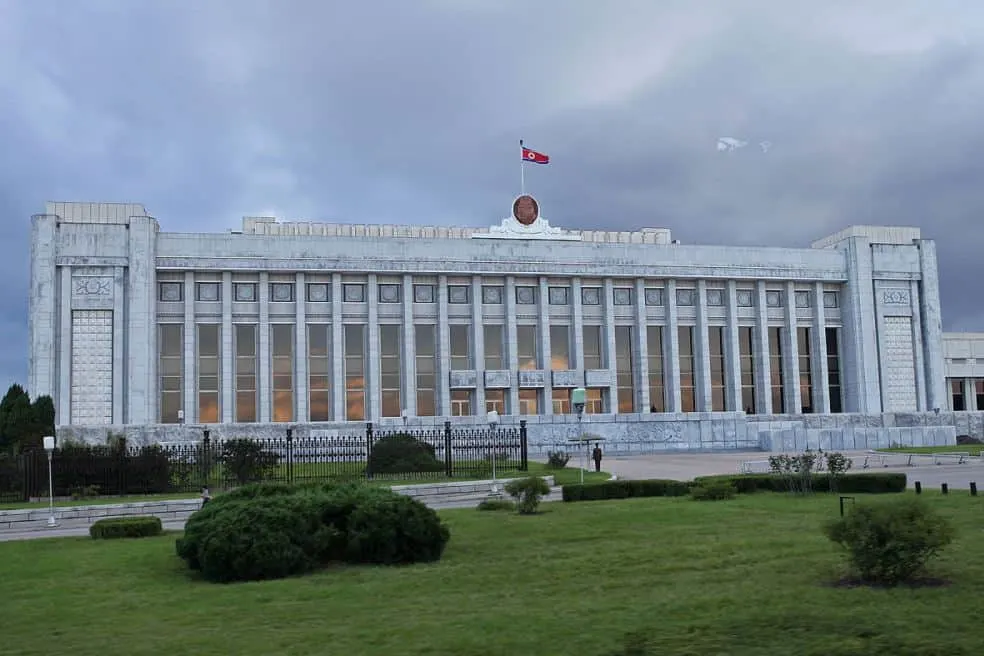
10. Workers’ Party Foundation Monument
The Monument to Party Founding is a monument in the center of the city that represents the core ideas of the country’s single political party.
It depicts a hammer, sickle, and calligraphy brush, which represent farmers, workers, and intellectuals.
The granite structure is much larger than it initially appears to be as it stands 50 meters (160 feet) tall. It’s not exactly located in a nice neighborhood, though.
It was built in 1995 and its height is a symbolic reference to the 50th anniversary of the Workers’ Party of Korea, an event that was celebrated that year.
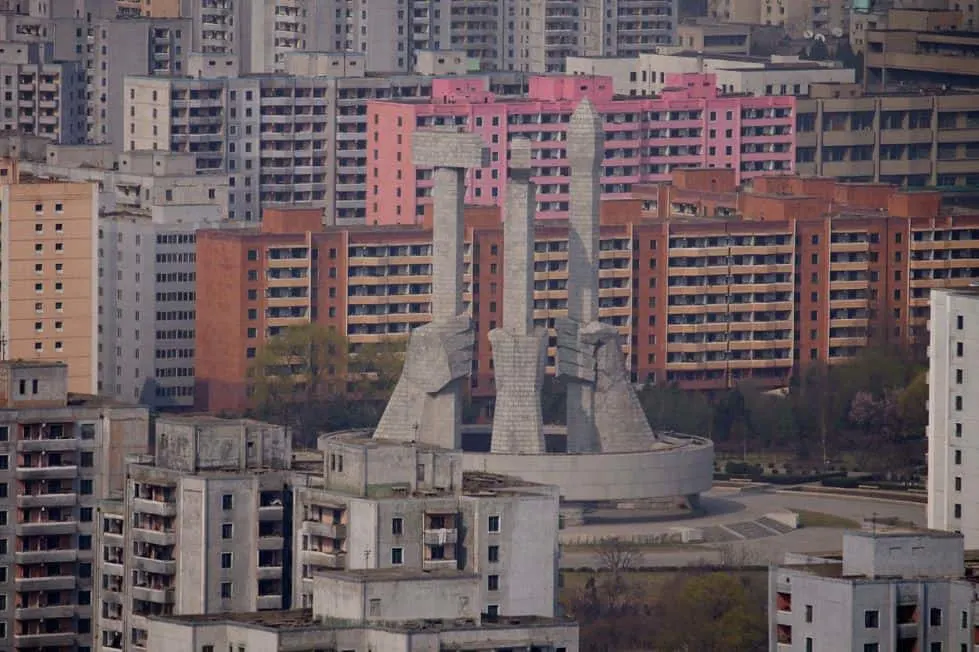
11. Arch of Reunification
The Arch of Reunification is officially known as the “Monument to the Three-Point Charter for National Reunification” and is a large sculptural arch located on the southern outskirts of the city.
It crosses the so-called “Reunification Highway” which leads from Pyongyang to the DMZ, the Korean Demilitarized Zone.
This enormous arch has a total width of 61.5 meters (202 feet) and a maximum height of 30 meters (98 feet).
It was completed in the year 2001 and was built to commemorate the proposals put forward by Kim Il-sung called the “Korean reunification proposals” a year earlier.

12. Pyongyang Metro
The Pyongyang Metro is the subway system in the capital of North Korea. Yes, they do have a subway here and it looks quite nice as well.
It has two lines which pretty much run from north to south and from west to east, and which intersect each other in the center of the city.
The original version of the metro was constructed between 1965 and 1973, which was the year that Kim Il-sung officially opened the first station.
Today, it’s the cheapest metro to ride in the world with tickets starting at just 5 North Korean won, the equivalent of just half a cent in US dollars.
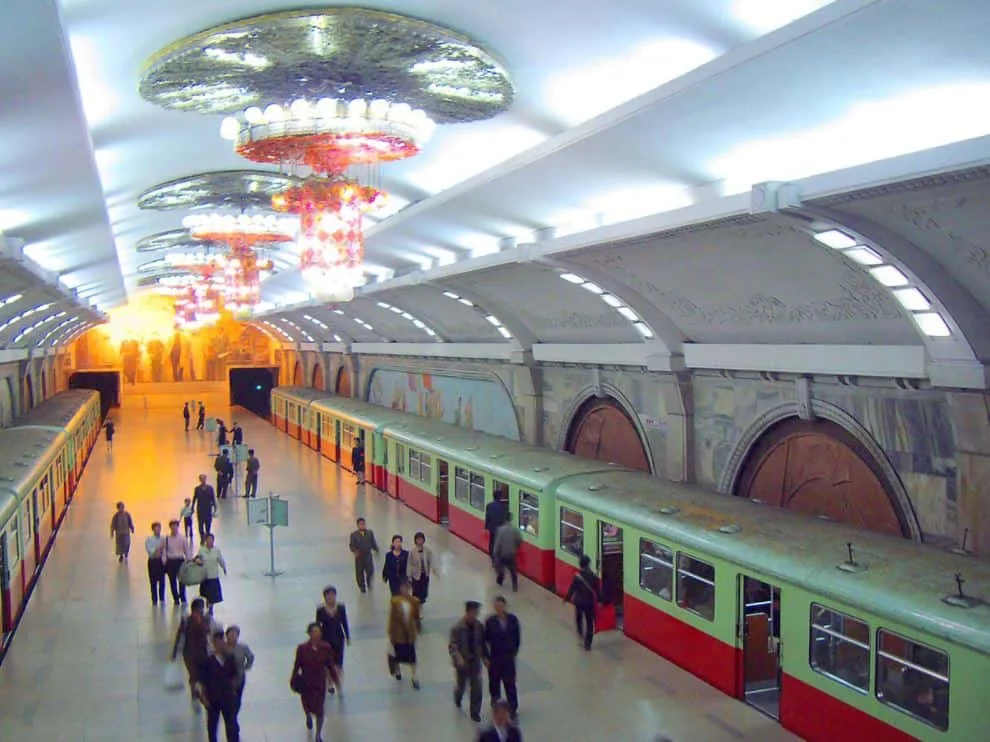
13. Taedongmun Gate
Taedongmun Gate is also referred to as the “Taedong Gate” as it was constructed on the banks of the Taedong River.
The original structure served as the eastern gate of the defensive wall of the castles of Pyongyang and was built in the 6th century.
The current structure was built in the year 1635 and is considered to be one of the National Treasures of North Korea, more specifically, National Treasure Number 4.
It has a granite base and is topped with a pavilion referred to as the “Euphoria Pavilion,” a structure that provides great views of the nearby river.

14. Tomb of King Tongmyŏng
The Tomb of King Tongmyŏng is an ancient mausoleum that consists of multiple tombs.
One of these is considered to be the tomb of King Tongmyŏng (58-19 B.C.), the founder of the Goguryeo kingdom that was located in the northern and central parts of the Korean Peninsula.
The entire complex covers an area of 233 hectares (580 acres) and has been listed as a UNESCO World Heritage Site in the year 2004.
It also features a Buddhist monastery which is located about 120 meters (390 feet) from the most famous tomb on the mausoleum grounds.

15. Yanggakdo International Hotel
If you ever do plan to visit North Korea, then the Yanggakdo International Hotel is most probably the place that you will end up staying.
It’s the largest operating hotel in the country and is located on Yanggak Island in the River Taedong. Like most buildings in Pyongyang, it doesn’t have a very appealing architectural design.
The hotel is situated about 2 kilometers (1.2 miles) to the southeast of the center of the city and stands 170 meters (560 feet) tall.
This makes it one of the tallest buildings in the city as well. It also features a tourist attraction in the form of a revolving restaurant on the 47th floor.
Yes, this is a hotel you can stay at in Pyongyang!
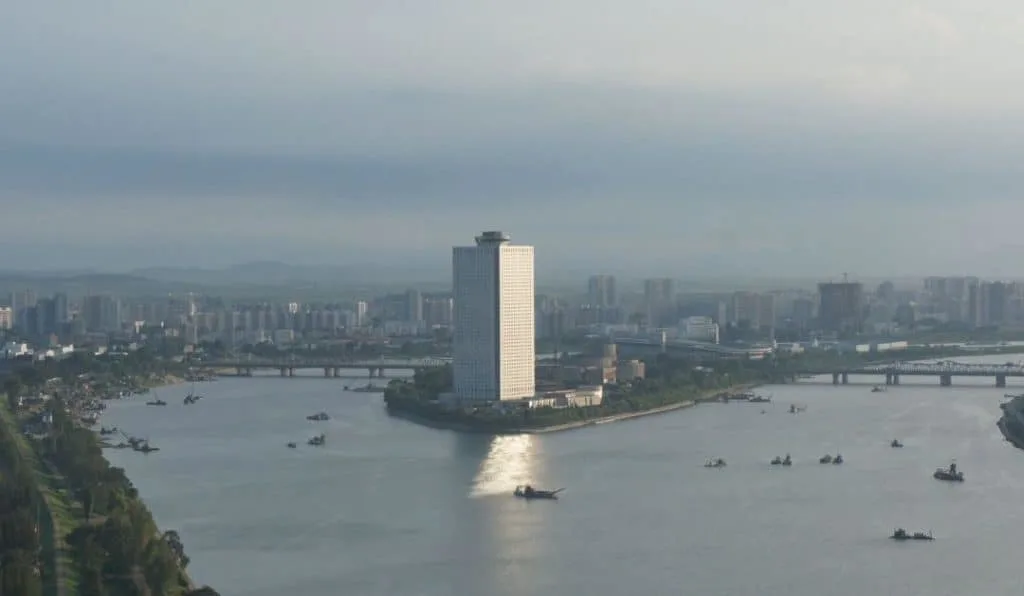
16. Victorious War Museum
The Victorious War Museum is also known as the “Victorious Fatherland Liberation War Museum” and is solely dedicated to the history of the Korean War.
This devastating war began on June 25, 1950, and ended (unofficially) on July 27, 1953. The result is an extremely secure border that is nearly impossible to pass without being shot at unless you are authorized to do so.
The museum was established just a month after the war had concluded in August 1953 to feed the propaganda machine.
The current building was completed in April 1963 and is located in the Sosong District, one of the central areas of Pyongyang.
The exhibits on display paint a perfect picture of the North Korean Fatherland that defeated the American enemy and its perceived puppet state of South Korea.
Another major renovation project in the city took place as this building was significantly expanded in 2014 and now features a large observation platform on the roof as well.
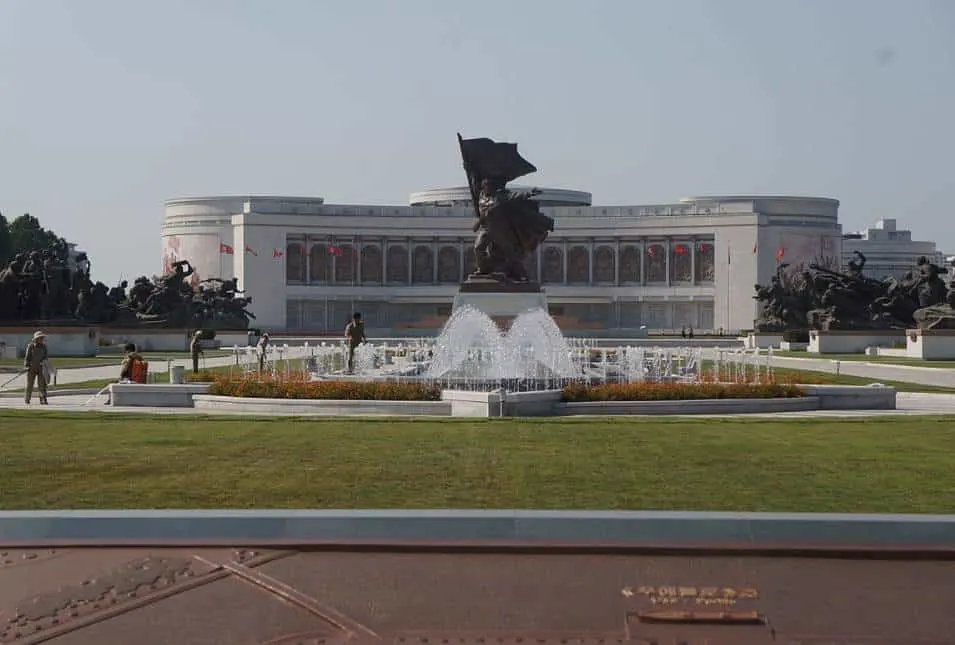
17. Munsu Water Park
One of the most surprising tourist attractions in Pyongyang is an immense water park located just east of Rungra Island Island in the central part of the city.
The Munsu Water Park officially opened its doors on October 15, 2013, an event attended by both the Prime Minister of the country named Pak Pong-Ju and numerous military leaders.
As with most attractions like this in North Korea, it remains unknown whether or not regular folks in the country can enjoy the facility.
The park covers an area of about 15 hectares (37 acres) and features 14 water slides. Visitors are welcomed by a huge statue of Kim Jong-Il in the lobby as well.
Another remarkable fact about this water park is that it was personally inspected by the Great leader of the country Kim Jong-Un who gave it his approval.

18. Chollima Statue
On the other side of the Taedong River, you can find a hill known as Mansu Hill. This relatively small hill is topped with a monumental statue of a winged horse.
The statue was erected in honor of the Chollima Movement, a Stakhanovite movement that emerged in North Korea shortly after the conclusion of the Korean War around 1956 or 1958.
In a nutshell, this meant the personal advice of the great leader to make more sacrifices for him and work harder for the state.
The statue was officially dedicated on April 15, 1961, in honor of the 49th birthday of Kim Il-Sung. Because he liked it so much, the statue won the “People’s Prize.”
This award is given by a government agency that works directly under the management of the country. In other words, the great leader is the one giving it.
The monument is huge as it stands 46 meters (151 feet) tall and represents a worker and a woman peasant riding a winged horse.
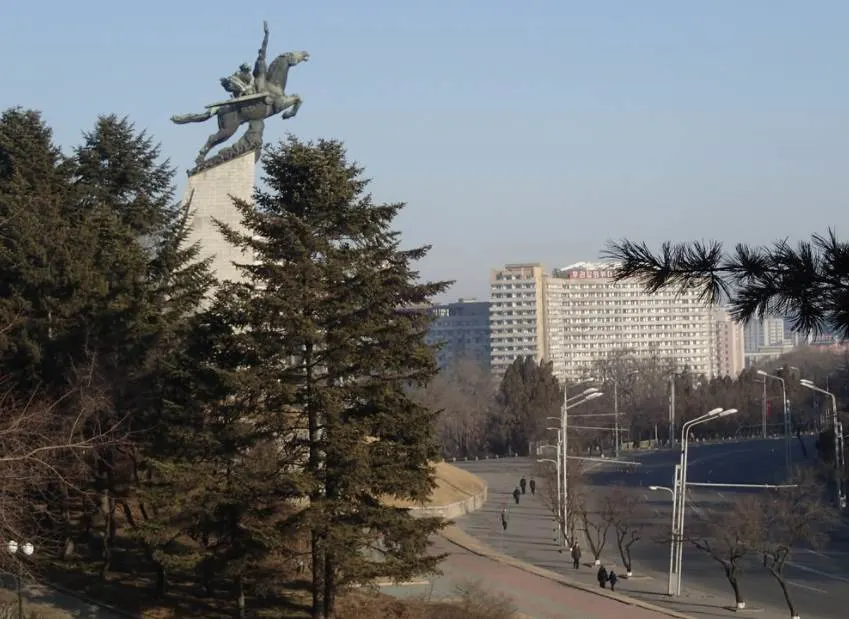
19. Mansudae Fountain Park
One of the best public parks to relax in the heart of the city is known as the Mansudae Fountain Park. as the name implies, it’s decorated with sculptures and fountains.
It also provides great views of the heart of the city as it’s located in a somewhat elevated location, making it a great place to take pictures as well.
The few tours that allow you to visit the city make this one of the first stops, mainly because of the great overview you get of the city just north of the heart of the city.
The great building you see in the background is the Mansudae Art Center and the park was originally established in 1976 as an extension of this building.
Another remarkable feature of this park is that it’s the main location where newly-wed North Korean couples take wedding pictures.
Even though the white sculpture of 28 women looks nice initially, they are performing a song called “snowfalls,” an anti-Japanese war song from 1965.
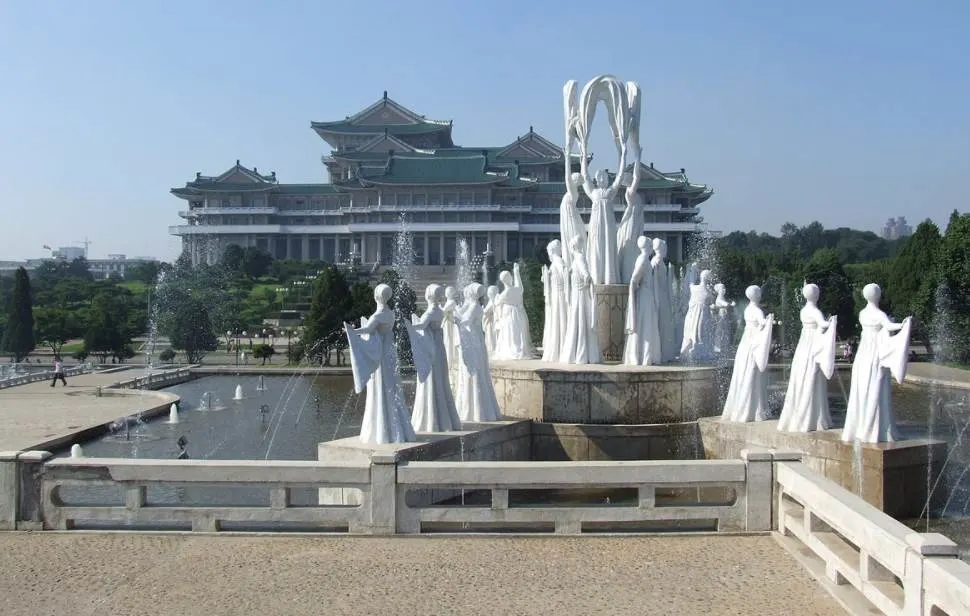
20. Pyongyang Central Zoo
The Pyongyang Central Zoo is also known as the “Korean Central Zoo” or “Central Ideals Zoo” and is the main zoo in the country.
It’s located in the northern part of the city near the foot of Mount Taesong and is situated just east of the Kumsusan Palace of the Sun.
The zoo has a remarkably large collection of wild animals as it’s home to over 5,000 animals and 650 different animal species.
The zoo has a pretty long history as well as it was established on the orders of Kim Il-Sung himself in the year 1959, most probably to serve as a zoo in his backyard.
The entrance of the zoo is quite fascinating as you’re walking into the mouth of a tiger.
The elephants inside the zoo are considered to be the main attraction and are all descendants of one individual named “Hero.”
This elephant was given to the great leader as a present from Vietnamese Communist leader Ho Chi Minh in 1959.
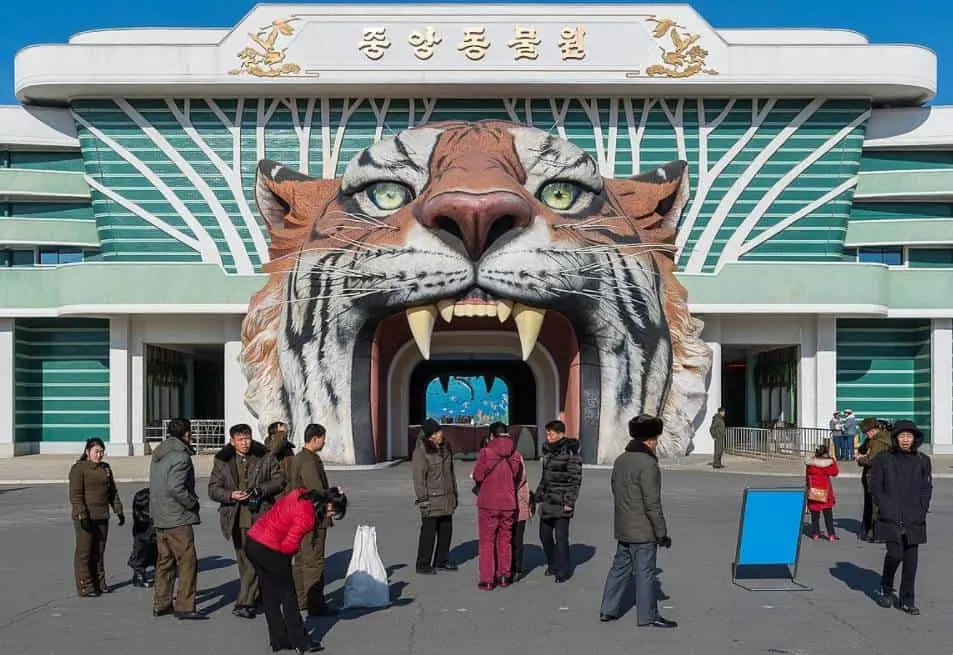
21. Grand People’s Study House
One of the most remarkable structures on Kim Il-Sung square, the heart of the city, is called the “Grand People’s Study House.”
This structure serves its purpose as the central library of Pyongyang and was another building constructed to commemorate the 70th-birthday of the supreme leader Kim Il-Sung.
This remarkable building was completed in April 1982 and took 21 months to build. It’s a prime example of the traditional Korean architectural style.
The building has a total floor space of about 100,000 square meters (1,100,000 square feet) which are divided over an astounding 600 rooms.
Apart from serving as a library that only features North Korean literature (foreign books can only be accessed by special people), it also serves as an indoctrination center of the North Korean regime.
This also means that it’s no surprise that it was built right across the Juche Tower, the ultimate manifestation of the North Korean dogma.
Admiring the architecture is pretty much the only thing that you can do here as a tourist.
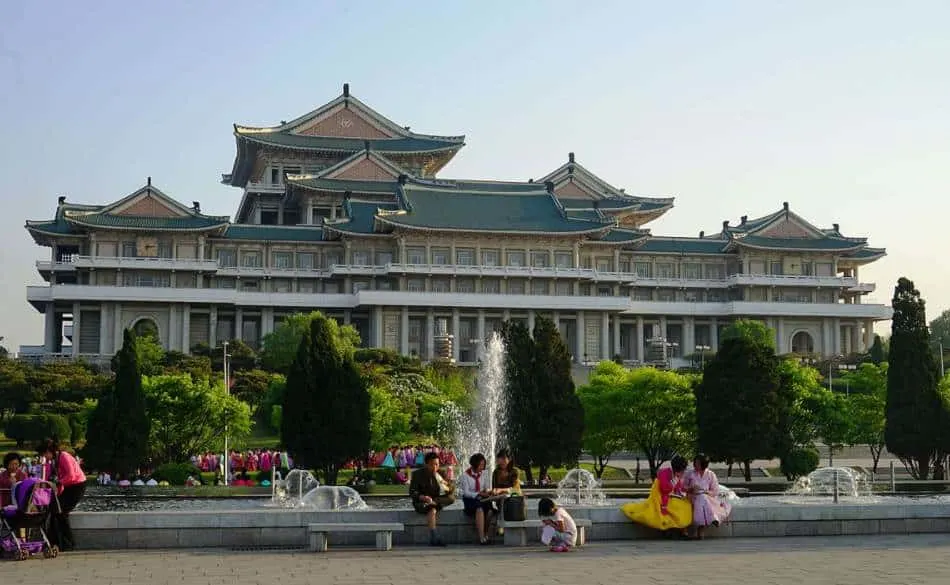
22. Korean Revolution Museum
Right behind the two enormous bronze statues of the two great leaders of North Korea at the Mansu Hill Grand Monument, we can find another museum.
This museum was one of the first to open following the establishment of the country as it opened its doors on August 1, 1948.
It shouldn’t be a surprise that it mostly features items directly related to the Korean Revolution, and more specifically, items directly related to the first great leader of the country, Kim Il-sung.
It remarkably also exhibits items from the 19th century, encompassing a period that extends from 1860 until the present day.
This place is huge as the museum features 90 enormous rooms that cover a total area of 240,000 square meters (2.58 million square feet).
That’ll keep you busy for a while, that’s for sure!

23. Kwangbop Temple
One of the historic monuments in North Korea that pre-dates the current regime by quite a stretch is the Kwangbop Temple.
The original version of this Buddhist Temple was constructed during the first half of the Korean Kingdom of Goguryeo (37 B.C. to 668 A.D.), more specifically during the reign of Gwanggaeto the Great (374-413 A.D.)
The temple was destroyed a couple of times during its history, including in 1700 and more recently during the Korean War in the 1950s.
The current version of the temple was only rebuilt in 1990 and features numerous gates, halls, and other buildings that were built around a 5-story pagoda.
Buddhist monks (or North Koreans pretending to be) take you on a tour of the complex during your visit.
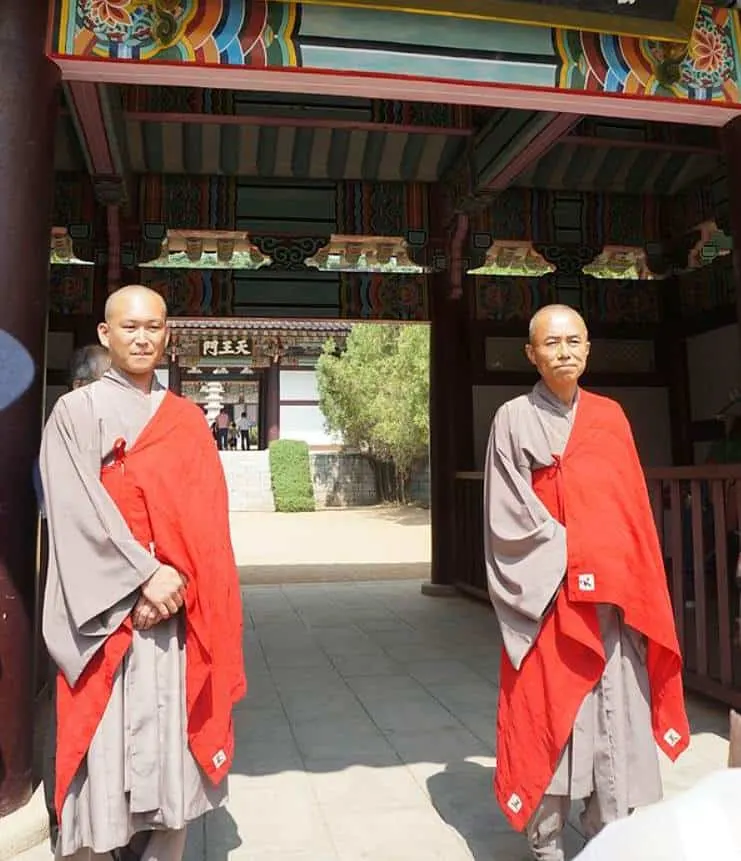
24. Korean Central History Museum
Another important museum in Pyongyang is the Korean Central History Museum, housed in a building located at the northern end of Kim Il-Sung Square.
The original version of the museum was established by the supreme leader himself on December 1, 1945, but this building was destroyed during the Korean War.
The collection of the museum wasn’t lost, though, and the current structure in which it’s housed was built in the 1960s.
The museum has artifacts on display that date back to ancient times to modern times, covering the entire history of Korea.
Even though it’s smaller than some of the other museums in the city it still has over 100,000 items on display.
There are located in 19 rooms covering an area of 10,500 square meters (113,000 square feet).
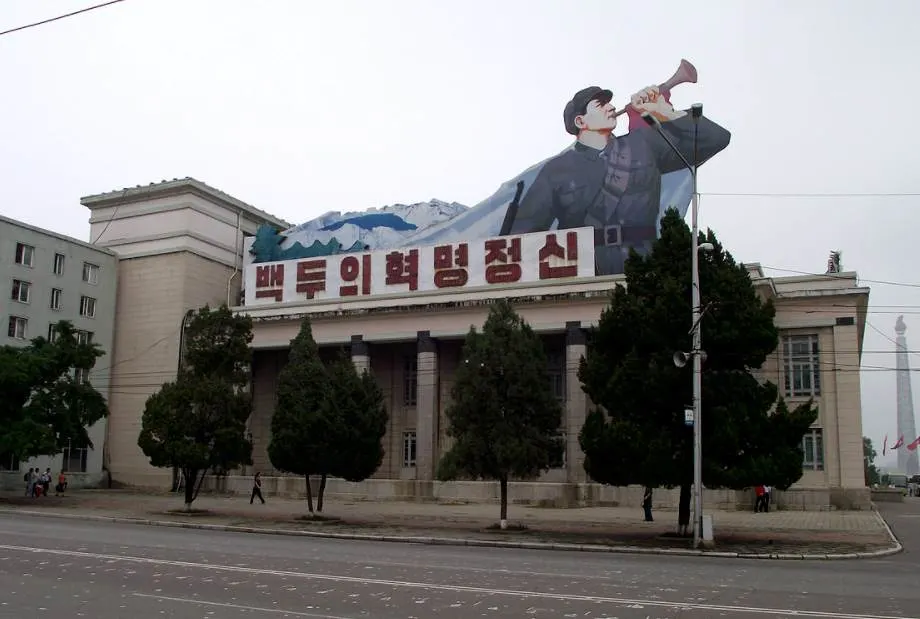
25. Pyongyang TV Tower
If you want to get an amazing view of the city and its surroundings then you won’t find a better place than the Pyongyang TV Tower.
This tower is located in Kaeson Park in the northern section of the city and stands 150 meters (490 feet) tall.
It was completed in 1967 and its design pretty much resembles that of the much taller Ostankino Tower in Moscow, even though it’s not as well-maintained.
Originally built to enhance the broadcast signals of the only television station in the country, the Korean Central Television, it also serves its purpose as a tourist attraction.
The observation deck and restaurant are located at a height of 94 meters (308 feet) above the ground below and offer stunning views of one of the most peculiar places in the world.

